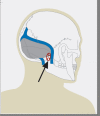Hemifacial spasm: conservative and surgical treatment options
- PMID: 23264807
- PMCID: PMC3487151
- DOI: 10.3238/arztebl.2012.0667
Hemifacial spasm: conservative and surgical treatment options
Abstract
Background: Hemifacial spasm is a neuromuscular movement disorder characterized by brief or persistent involuntary contractions of the muscles innervated by the facial nerve. Its prevalence has been estimated at 11 cases per 100 000 individuals. Among the patients who were operated on by our team, the mean interval from diagnosis to surgery was 8.2 years, and more than half of them learned of the possibility of surgical treatment only through a personal search for information on the condition. These facts motivated us to write this article to raise the awareness of hemifacial spasm and its neurosurgical treatment among physicians who will encounter it.
Methods: This review article is based on a selective literature search and on our own clinical experience.
Results: Hemifacial spasm is usually caused by an artery compressing the facial nerve at the root exit zone of the brainstem. 85-95% of patients obtain moderate or marked relief from local injections of botulinum toxin (BTX), which must be repeated every 3 to 4 months. Alternatively, microvascular decompression has a success rate of about 85%.
Conclusion: Local botulinum-toxin injection is a safe and well-tolerated symptomatic treatment for hemifacial spasm. In the long term, however, lasting relief can only be achieved by microvascular decompression, a microsurgical intervention with a relatively low risk and a high success rate.
Figures







References
-
- Auger RG, Whisnant JP. Hemifacial spasm in Rochester and Olmsted County, Minnesota, 1960 to 1984. Arch Neurol. 1990;47:1233–1234. - PubMed
-
- Nilsen B, Le KD, Dietrichs E. Prevalence of hemifacial spasm in Oslo, Norway. Neurology. 2004;63:1532–1533. - PubMed
-
- Tan EK, Chan LL. Young onset hemifacial spasm. Acta Neurol Scand. 2006;114:59–62. - PubMed
-
- Yaltho TC, Jankovic J. The many faces of hemifacial spasm: differential diagnosis of unilateral facial spasms. Mov Disord. 2011;26:1582–1592. doi: 10.1002/mds.23692. - PubMed
-
- Felício AC, Godeiro-Junior Cde O, Borges V, Silva SM, Ferraz HB. Bilateral hemifacial spasm: a series of 10 patients with literature review. Parkinsonism Relat Disord. 2008;14:154–156. - PubMed
Publication types
MeSH terms
Substances
LinkOut - more resources
Full Text Sources
Medical

